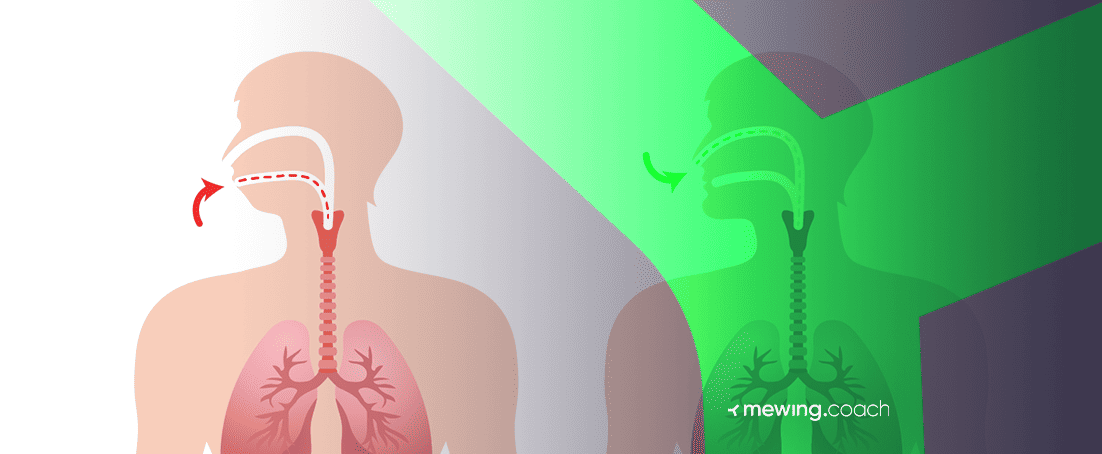There is a growing debate on nose vs. mouth breathing. Namely, the former benefits a person’s facial and respiratory performance, whereas the latter can lead to devastating downsides. When nasal breathing is done naturally, the mouth remains closed and the tongue rests against the palate. But, if not positioned right, improper breathing is likely to happen.
When nasal breathing is obstructed due to allergy blockage, cold, a deviated septum, asthma, or fractures, mouth breathing is a natural response. But, perpetual mouth breathing can lead to many facial abnormalities and severe nasal cavities, teeth, and jaw issues.
In this guide, we’ll help you learn all about:
- 🤔 The possible facial changes caused by mouth breathing
- 📖 The reasons why mouth breathing is harmful compared to nasal breathing
- 📝 The causes and symptoms of mouth breathing and how to switch to nasal breathing

Mouth Breathing Causes and Symptoms
If you’re a mouth breather during sleep, this is probably due to an obstruction of the nasal passage airflow. As a result, you might experience various sleep-related issues, from snoring to complex deep sleep apnea.
The oxygen level absorbed in the chest is better received from nasal rather than mouth breathing. When the air comes from the nose, it is more temperature-regulated, filtered, and powerful. On the flip side, mouth breathers show less efficient breathing patterns.
Some of the leading causes of mouth breathing could include:
- Wrongful sleep position
- Excess weight
- Large tongue
- Excessive alcohol consumption
- Expanded or swollen tonsils
Our noses make excellent air filters. They purify the air before it enters our lungs, whereas mouth breathing lets unfiltered and bacteria-prone air into the lungs. This can lead to bad breath or more severe health issues, like exposing the lungs to moisture.
What Does a Mouth Breather’s Face Look Like?
A chronic mouth breather will typically have a poor facial profile and will be more prone to develop an elongated facial structure with a smaller jaw, dwarf-looking mouth, and retracted chin. Compared to mouth breathing, nasal breathing promotes and supports healthy facial development from an early age.
Keep reading to learn about the typical facial structure of a mouth breather.
Mouth Breathing Changes Your Jawline
Overbite and recessed chins are the most noticeable features in mouth breathers. Instead of maintaining a firm and steady structure, with mouth breathing, both the jaw and bite will withdraw towards the neck, resulting in a double chin appearance.
Poor Neck Posture
Due to the throat and face shape, a mouth breather must bend over and thrust their head forward to make an unobstructed pathway for the air to reach the lungs. A lousy neck and back posture due to mouth breathing can make a person appear shorter and cause additional muscle ailments and distortion.
Less Prominent Cheeks
People who breathe through their mouths tend to have droopy eyes. They might also experience dark circles around the eyes due to inefficient breathing, and a lack of venous drainage. Mouth breathing can decrease the cheek volume and positioning, and leads the maxilla to recede.
Crooked Teeth
The neck and lower and upper jaw muscles are formed based on the way we breathe. When we breathe through the mouth, our tongues rest unnaturally and exert an unnatural force on the teeth. This force can shift the teeth, or even cause a narrow palate. As a result, the teeth won’t have any space to grow, leading to crooked teeth.
Large Nose
The maxilla recedes due to a combination of persistent mouth breathing and bad tongue posture. As a result, the face will be forced to shift and drag the nose downward with it.
This will ultimately result in a hooked and more prominent nose.
Long Face Syndrome and Mouth Breathing Habit
People who breathe through the mouth are likely to experience some unpleasant side effects and may be predisposed to Long Face Syndrome. Luckily, the issue can be treated with sufficient therapy and exercises, or in the worst-case scenario, surgery.
The Long Face Syndrome is characterized by a long, narrow face, a direct result of craniofacial growth issues or airway obstructions. Besides witnessing longer and narrower facial appearance, other common syndrome symptoms include a gingival smile (an excess show of gums above the teeth), an undefined neck appearance, and a prominent chin.
Another distinguishing feature is known as a skeletal open bite. It is caused by unbalanced pressure on the jaw and results in teeth gaps and protruding teeth rows. if left untreated, a skeletal open bite can worsen the facial appearance. Fortunately, orthodontic interventions and exercises such as mewing can help reposition the airways and make for smoother nasal breathing.
Individuals who are unable to breath nasally will often fall victim to this syndrome. However, healthcare professionals promise to prevent the syndrome’s severity to an extent, especially in children. Monitoring for any allergies, ensuring proper jaw growth through exercises, and preventing mouth breathing habits early on are some of the ways to do this.
Mouth Breathing and Facial Growth in Children
Breathing orally is frequently connected with a decreased oxygen intake into the lungs. As a result, this may lead to fatigue, sleep disruptions, irritability, and poor concentration commonly related to ADHD symptoms.
Incorrect breathing can cause permanent damage to developing children. If a child’s nasal airways are constantly compromised, the body will adapt to breathing orally. This will then lead to facial asymmetry and other severe children facial growth changes.
Breathing through the mouth may cause neck and head posture changes, which can lead to a so-called “adenoid face.” Such a facial structure includes a narrow upper dental arch, incisor changes, and expanded facial height.
Due to the lack of normal air resistance, children who are mouth breathers will usually have a smaller mid-face area, jaw, and nasal cavities.
As children develop, breathing patterns and practicing nose breathing resistance will aid in more proportional facial structure changes. Children are especially vulnerable to oral breathing changes. Especially children aged 6 to 12 years will be more likely to develop a converse facial shape.
It is also worth mentioning that increased adenoids are linked to higher rates of sleep apnea in kids. Children suffering from this condition may be more likely to breathe orally during sleep. Untreated adenoids may worsen the natural facial structure in kids. The good thing is that doctors can treat increased adenoids surgically, thus preventing permanent facial changes.
How to Correct Mouth Breathing
In all fairness, breathing through the mouth can be dangerous for adults and kids. But, while nasal breathing is recommended, the practice takes some getting used to and it can be easier said than done. The good news, there are several ways to shift from oral to nasal breathing and maximize the oxygen supply to the chest.
Here are some of the approaches that can help you switch from mouth to nasal breathing.
Mewing
Breathing through the mouth can cause a tied tongue and lead to poor tongue function. Tongue ties limit the tongue’s range of movement and prevent the tongue from extending and moving as needed. Luckily, one can develop correct tongue posture by mewing.
Interestingly, there are many mewing benefits to consider overall, including treating Long Face Syndrome, improving nasal breathing, and redefining the jaw and facial structure.
Mewing involves pressing the tongue against the teeth’ soft tissue in an effort to enhance your facial features. It’s intended to counteract the harmful effects of incorrect mouth breathing and tongue positioning. With proper tongue posture and nose breathing techniques, you can correct your mouth-breathing face.
How to Mew Right?
To nail the mewing technique, follow these steps:
- Put your lips together.
- Adjust your jaw so that your lower front teeth are behind the upper front teeth.
- Use your tongue to cover the roof of your mouth.
- Place the tip of your tongue, without touching, directly behind your front teeth.
Individuals younger than 18 can expect favorable results in 1-3 months, those aged 18 to 25 will see first results in 3-6 months, and mewers older than 25 can expect first results after 6 months to a year. For more details on the practice, resort to this mewing resource – or consult a therapist to determine the rightful course of action.
Nose Breathing Exercises
Nose breathing exercises can help patients struggling with mouth breathing to improve their lung function, strengthen respiratory muscles, and reduce stress in the jaw and body.
Nasal breathing is a recommended practice, mainly because of the high-quality oxygen volume it brings to the lungs.
The best nasal breathing exercise to start with has to be box breathing. Follow these steps to make sure you’re doing it correctly:
- Place one hand on the belly and the other on the chest.
- Slowly inhale and count to four, allowing the air to fill your lungs.
- Keep an eye on the rise and fall of your belly and chest.
- Hold your breath for four seconds, without inhaling or exhaling.
- Exhale slowly for four seconds, through the mouth.
Do this exercise as often as you can and push the tummy out while taking slow, deep breaths. A huge benefit of box breathing is that it helps relax the facial muscles and jaw. The first results of box breathing will come after a few weeks of practicing.
Eliminate Airway Obstruction
Many people tend to be mouth breathers simply because they have never been taught to adopt nasal breathing. Plus, sinus swelling, nasal polyp growth, and infections can make breathing through the nose more difficult. Blood vessel enlargement can also cause obstructions in the nose passageways, which then turns nose breathers into mouth breathers.
Luckily, various treatments can help open up the nasal airways. For example, nasal inhalers aid in the shrinking of blood vessels and create an air passage. You can clear any blockages in the passages with a nasal wash or turmeric. Nasal decongestants, nasal steroid sprays, allergy medications, nasal dilators, and saline mist, are also helpful in eliminating nasal airway obstructions.
Wrap Up
If left untreated, chronic mouth breathing can cause severe muscle changes in the tongue, neck, face, and jaw. The atypical pull of facial muscles and bones will gradually change their appearance and lead to serious asymmetry, pain, and dislocation.
Treating these issues on time and in the right manner is paramount for favorable results. Some of the most successful ways to treat such issues include doing mewing exercises, nose exercises, and eliminating airway obstructions – if any.
If left untreated, facial deformities will become too complex for orthodontic treatment and instead require jaw or nasal airway surgery.





